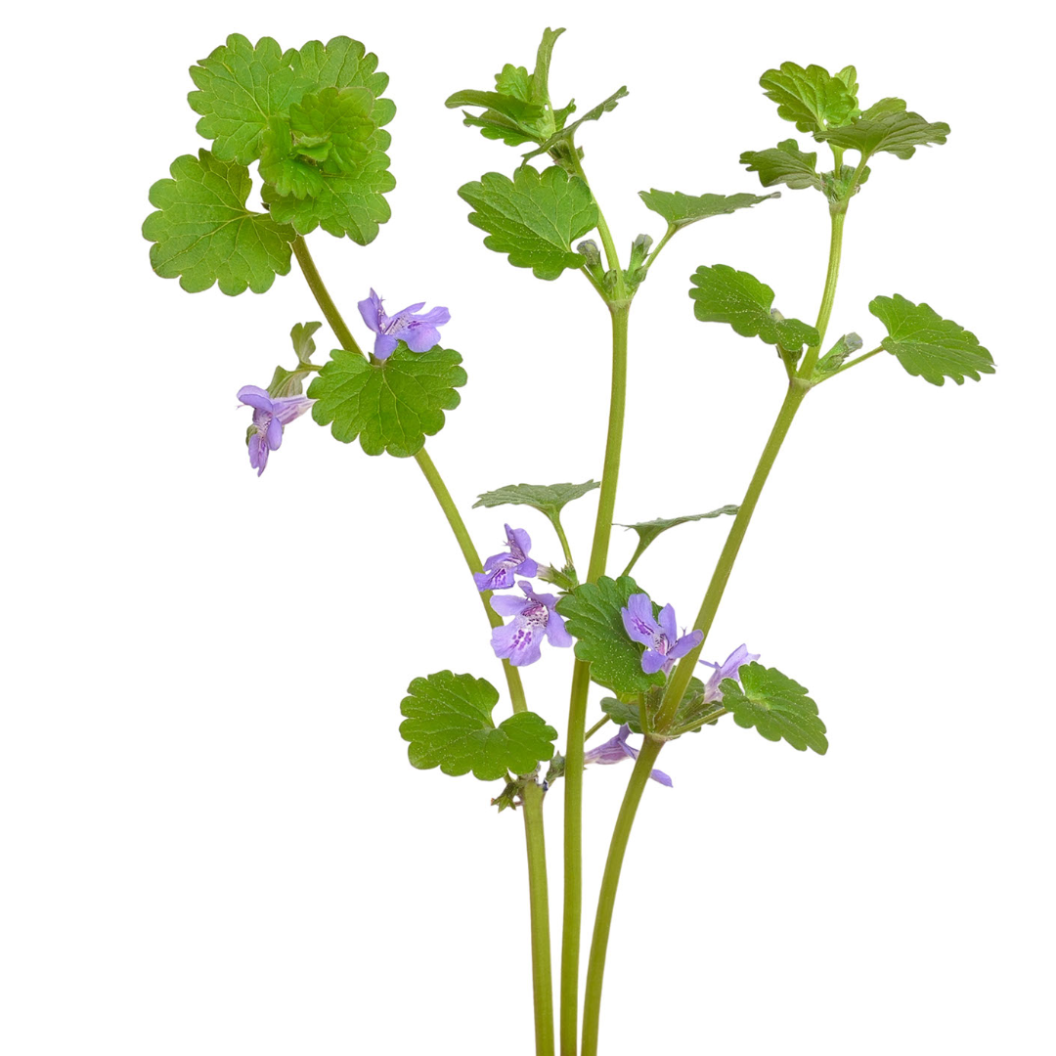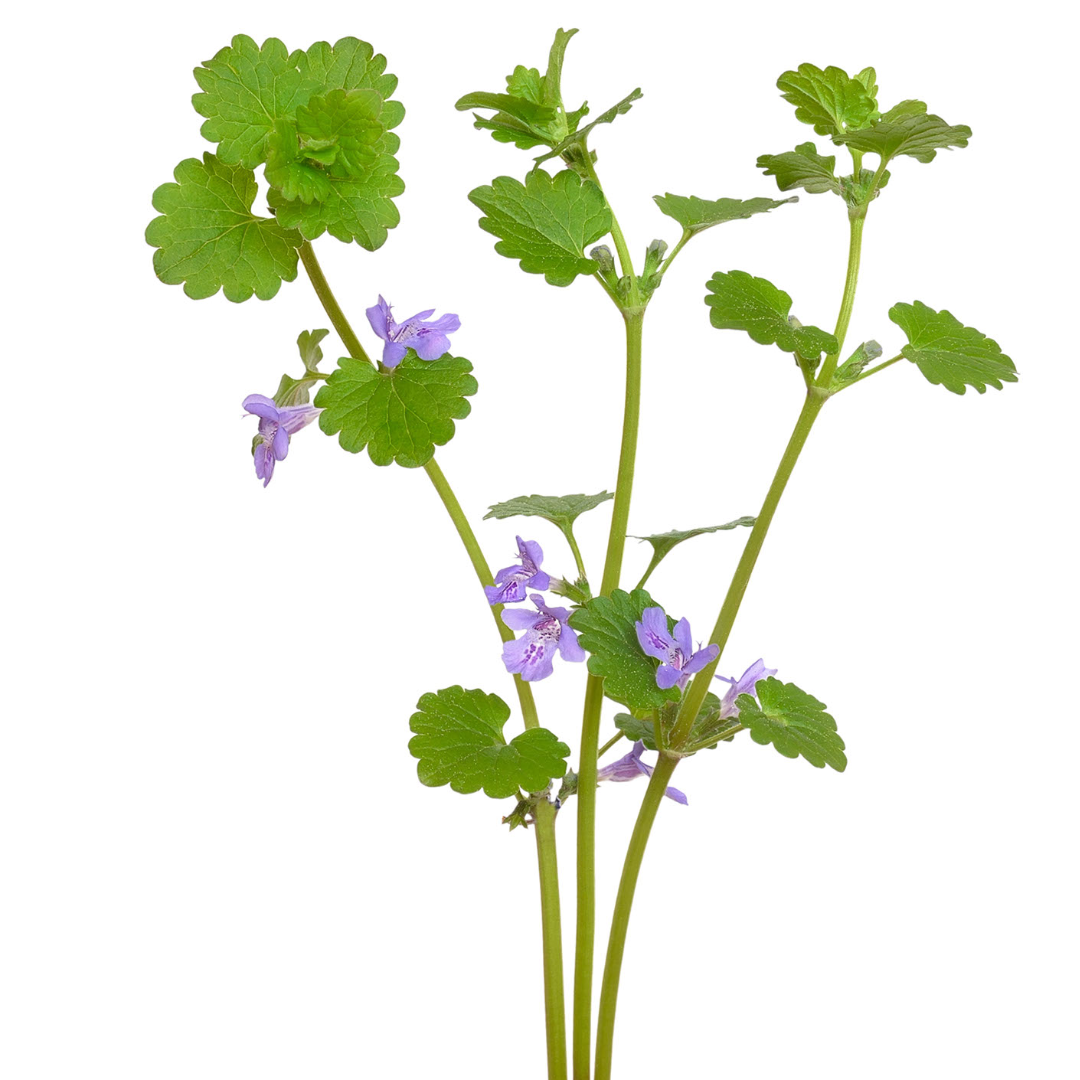
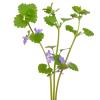
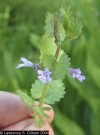


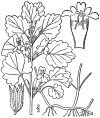
Creeping Charlie
DESCRIPTION: Creeping Charlie is an evergreen creeper in the mint family that grows close to the ground and spreads rapidly like a carpet. It has been known to completely take over lawns or gardens when not properly controlled. It is a pretty little plant that people either love or hate.
SCIENTIFIC NAME: Glechoma hederacea
OTHER NAMES: Ground Ivy, Gill-Over-The-Ground, Alehoof, Run-Away-Robin, Catsfoot, Field Balm, Creeping Jenny, Tunhoof, Robin-Run-In-The-Grass
LEAF TYPE: Broadleaf
FLOWERS: The flowers are small and delicate with a lovely shade of bluish-purple. The have a destinctive shape with a tubular base and flared petals that give it a somewhat trumpet-like appearance. They are arranged in two lips with the upper lip forming a hood and the lower lip having three lobes. They are quite small and grow in clusters at the base of the leaves, often hidden among the foliage. When in bloom, they add a beautiful splash of color to the green carpet of the plant.
LEAVES: The leaves are small and kidney shaped, with a slightly wrinkled texture. They grow in pairs, directly across from each other on the stem, and have scalloped edges that give them a lacy look. They are bright in color and have veins that branch out from their center to resemble a tree. When crushed, the leaves give off a mild, minty scent. Since they grow low to the ground, they often form a very dense mat of greenery.
LIFE CYCLE: Perennial
HOW TO IDENTIFY: Look for a low-growing plant that forms a mat of greenery close to the ground. It will have small, rounded leaves with scalloped edges that grow in pairs. The leaves will be bright green and have branching veins that form a network throughout the leaf. When crushed it'll give off a minty scent. It will have small bluish-purple flowers that grow in clusters at the base of the leaves and will often be hidden among the foliage. Creeping Charlie spreads quickly and can rapidly take over a lawn or garden if left unchecked.
MECHANICAL CONTROL RECOMMENDATIONS:
1. Regular Mowing - More Info
2. Hand Pulling - More Info
3. Thatch removal - More Info
4. Overseeding - More Info
5. Weed Barriers - More Info
6. Regular Maintenance - More Info
7. Avoid Overwatering - More Info
8. Healthy Lawn Practices - More Info
9. Use of Lawn Tools- More Info
8. Landscape Fabric - More Info
It's essential to remember that mechanical control alone may not entirely eliminate Poa annua, especially in areas where the grass is actively managed, like golf courses and sports fields. Combining mechanical methods with chemical control and cultural practices can offer more effective long-term management. Always follow best practices and local regulations when using herbicides or pesticides. For large-scale control efforts, it's a good idea to consult with a professional turfgrass manager or horticulturist.
CHEMISTRY RECOMMENDATIONS:
"Pre-emergent herbicides:
Prodiamine: Often used for pre-emergent control of broadleaf weeds, prodiamine can provide some suppression of ground ivy by preventing the germination of its seeds. Apply it in early spring before weed seeds start to germinate.
Dithiopyr: Similar to prodiamine, dithiopyr is used for broadleaf weed control. It may offer some suppression of ground ivy. Apply it before weed seeds germinate in the spring or early fall.
Trifluralin: Trifluralin is another pre-emergent herbicide that can provide some control over broadleaf weeds. It's important to read the label and follow the manufacturer's recommendations for application.
Benefin: Benefin is commonly used for pre-emergent control of various broadleaf and grassy weeds. While its effectiveness against ground ivy might be limited, it could still offer some suppression.
Isoxaben: Isoxaben is a pre-emergent herbicide known for its broad-spectrum control of broadleaf weeds. While it may not be highly effective against ground ivy, it could still have some impact.
Post-emergent herbicides:
2,4-D: 2,4-D is a selective broadleaf herbicide that targets broadleaf weeds like ground ivy while leaving grasses relatively unharmed. It's often found in combination products. Make sure to follow label instructions and avoid application on windy days to prevent drift.
Dicamba: Dicamba is another selective herbicide effective against broadleaf weeds. It can be used for controlling ground ivy. Always apply dicamba according to label instructions to minimize the risk of damage to non-target plants.
Triclopyr: Triclopyr is effective against a wide range of broadleaf weeds, including ground ivy. It's often available in formulations designed specifically for lawn use. Carefully follow the instructions on the label.
MCPA: MCPA is a post-emergent herbicide that targets many broadleaf weeds, including ground ivy. It's often used in combination with other active ingredients for more effective control.
Quinclorac: While primarily used for controlling crabgrass and certain grassy weeds, quinclorac can also provide some control over ground ivy when used at higher rates.
Carfentrazone: This herbicide is effective against a variety of broadleaf weeds, including ground ivy. It can provide fast-acting results but might require repeat applications.
Glyphosate: Glyphosate is a non-selective herbicide that can effectively kill most plants, including ground ivy. However, it will also kill desirable grasses and plants, so it should be used with caution and only on non-lawn areas.
Sulfentrazone: Sulfentrazone is a herbicide that can provide control over ground ivy, especially when used in combination with other active ingredients. It's often found in products labeled for broadleaf weed control.
Selective herbicides:
2,4-D: 2,4-D is a popular selective herbicide that targets broadleaf weeds, including ground ivy. It's often found in combination products and is effective when used according to label instructions.
Triclopyr: Triclopyr is effective against a range of broadleaf weeds, including ground ivy. It's available in formulations designed for lawn use, making it a suitable option.
MCPA: MCPA is a selective herbicide that targets many broadleaf weeds, including ground ivy. It can be found in various lawn weed control products.
Dicamba: Dicamba is another selective herbicide effective against broadleaf weeds. It's important to follow label instructions closely to prevent off-target damage.
Quinclorac: Quinclorac is primarily used for controlling crabgrass and certain grassy weeds, but it can also provide some control over ground ivy at higher rates.
Carfentrazone: Carfentrazone is a selective herbicide effective against many broadleaf weeds, including ground ivy. It can provide fast-acting results.
Sulfentrazone: Sulfentrazone is found in products labeled for broadleaf weed control. It can offer control over ground ivy when used in combination with other active ingredients.
Trifluralin: Trifluralin is primarily used as a pre-emergent herbicide, but it can also have some post-emergent control over young ground ivy plants.
Bentazon: Bentazon is a selective herbicide effective against certain broadleaf weeds, including ground ivy. It's often used in turfgrass settings.
Non-Selective herbicides:
Glyphosate: Glyphosate is one of the most widely used non-selective herbicides. It kills virtually all plants it comes into contact with. While effective against ground ivy, it will also kill desirable grasses and plants, so it should only be used in non-lawn areas or for spot treatments.
Glufosinate: Glufosinate is another non-selective herbicide that can be used to control ground ivy. Like glyphosate, it will kill most plants it contacts and should be used with caution.
Diquat: Diquat is a non-selective herbicide that works quickly to desiccate and kill plants. It's often used for non-selective burndown treatments in areas where complete vegetation removal is desired.
Pelargonic Acid: Also known as ""horticultural vinegar,"" pelargonic acid is a natural non-selective herbicide that can be used for spot treatments. It causes rapid desiccation of plant tissues.
Acetic Acid: Acetic acid-based herbicides, often labeled as ""vinegar herbicides,"" are non-selective and can be used for spot treatments. They are effective against young, actively growing plants.
Recommended Prevention
Recommended Control

